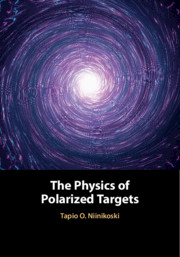Book contents
- The Physics of Polarized Targets
- The Physics of Polarized Targets
- Copyright page
- Dedication
- Contents
- Preface
- Acknowledgements
- 1 Introduction to Spin, Magnetic Resonance and Polarization
- 2 Resonance and Relaxation of Interacting Spin Systems
- 3 Electron Paramagnetic Resonance and Relaxation
- 4 Dynamic Nuclear Polarization
- 5 Nuclear Magnetic Resonance and Relaxation
- 6 NMR Polarization Measurement
- 7 Polarized Target Materials
- 8 Refrigeration
- 9 Microwave and Magnet Techniques
- 10 Other Methods of Nuclear Spin Polarization
- 11 Design and Optimization of Polarized Target Experiments
- Appendices
- Index
- References
6 - NMR Polarization Measurement
Published online by Cambridge University Press: 03 February 2020
- The Physics of Polarized Targets
- The Physics of Polarized Targets
- Copyright page
- Dedication
- Contents
- Preface
- Acknowledgements
- 1 Introduction to Spin, Magnetic Resonance and Polarization
- 2 Resonance and Relaxation of Interacting Spin Systems
- 3 Electron Paramagnetic Resonance and Relaxation
- 4 Dynamic Nuclear Polarization
- 5 Nuclear Magnetic Resonance and Relaxation
- 6 NMR Polarization Measurement
- 7 Polarized Target Materials
- 8 Refrigeration
- 9 Microwave and Magnet Techniques
- 10 Other Methods of Nuclear Spin Polarization
- 11 Design and Optimization of Polarized Target Experiments
- Appendices
- Index
- References
Summary
The principles of the continuous-wave (CW) NMR techniques is reviewed, as applied to the measurement of the nuclear polarization in polarized targets. The circuit theory of the series-tuned Q-meter is then described in detail in view of calculating precisely the CW NMR absorption signal and its integral, the signal-to-noise ratio, the probe coupling and sampling, and the signal saturation. Optimization of the series-tuned Q-meter circuit is discussed on the basis of the circuit theory. Improved Q-meter circuits will be reviewed, including the capacitively coupled Q-meter, the crossed-coil NMR circuit, and the introduction of quadrature mixer that enables the measurement of the real and imaginary parts of the RF signal simultaneously. Calibration and measurement of very small NMR signals then follows. We also treat the signal-to-noise issues, the electromagnetic interferences, and the NMR circuit drift issues.
Keywords
- Type
- Chapter
- Information
- The Physics of Polarized Targets , pp. 245 - 282Publisher: Cambridge University PressPrint publication year: 2020



